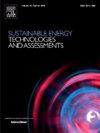Impact of roto-till drill on energy saving in wheat production using difference-in-difference method
IF 7
2区 工程技术
Q1 ENERGY & FUELS
Sustainable Energy Technologies and Assessments
Pub Date : 2025-05-22
DOI:10.1016/j.seta.2025.104358
引用次数: 0
Abstract
Energy efficiency and sustainable practices are critical for addressing environmental concerns and improving resource use in agriculture. Conventional farming methods result in higher energy consumption whereas resource conservation machinery such as roto-till drill offers potential to increase energy use efficiency. This study assessed the impact of roto-till drill used in wheat cultivation in Central India. Selected farmers engaged in wheat cultivation in Bhopal region of Central India were categorized into two groups: control and treated. Control group practiced conventional farming (tillage with MB plough or cultivator and seed sowing using seed drill or seed-cum-fertilizer drill) and treated group used roto-till drill for sowing of wheat. The energy use efficiency (EUE), specific energy (SE), carbon emission, and yield were measured for both groups, pre- and post-interventions of roto-till drill. The difference-in-difference (D-I-D) method was used to estimate the impact of roto-till drills on energy parameters. The EUE of control group was 10.75 and 9.93 in pre- and post-period respectively, while treated group observed 10.41 and 15.90. Furthermore, the treated group were able to significantly increase their EUE by 6.30 in comparison to the control group. In addition, the treated group used 2.57 MJ lesser energy than the control group to produce one kilogram of wheat. There was no significant impact of roto-till drill in reducing carbon emission and increasing yield. Overall, adoption of the roto-till drill significantly increased EUE without affecting the yield of the wheat crop.
差中差法轮作机对小麦节能的影响
能源效率和可持续做法对于解决环境问题和改善农业资源利用至关重要。传统耕作方法导致较高的能源消耗,而资源节约机械,如旋耕机,提供了提高能源利用效率的潜力。本研究评估了轮耕机在印度中部小麦种植中的影响。选择在印度中部博帕尔地区从事小麦种植的农民分为两组:对照组和处理组。对照组采用常规耕作方式(MB犁或耕耘机耕作,播种机或种肥机播种),试验组采用旋耕播种机播种。测量了两组、轮作钻机干预前后的能量利用效率(EUE)、比能(SE)、碳排放和产量。采用差中差法(D-I-D)估计旋耕钻机对能量参数的影响。对照组术前和术后的EUE分别为10.75和9.93,治疗组为10.41和15.90。此外,与对照组相比,治疗组的EUE显著提高了6.30。此外,处理组每生产1公斤小麦消耗的能量比对照组少2.57兆焦耳。旋耕机在减少碳排放和提高产量方面没有显著效果。总体而言,采用轮作播种机显著提高了高效能利用效率,但不影响小麦作物的产量。
本文章由计算机程序翻译,如有差异,请以英文原文为准。
求助全文
约1分钟内获得全文
求助全文
来源期刊

Sustainable Energy Technologies and Assessments
Energy-Renewable Energy, Sustainability and the Environment
CiteScore
12.70
自引率
12.50%
发文量
1091
期刊介绍:
Encouraging a transition to a sustainable energy future is imperative for our world. Technologies that enable this shift in various sectors like transportation, heating, and power systems are of utmost importance. Sustainable Energy Technologies and Assessments welcomes papers focusing on a range of aspects and levels of technological advancements in energy generation and utilization. The aim is to reduce the negative environmental impact associated with energy production and consumption, spanning from laboratory experiments to real-world applications in the commercial sector.
 求助内容:
求助内容: 应助结果提醒方式:
应助结果提醒方式:


